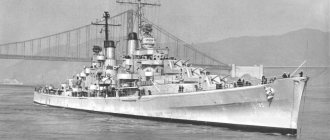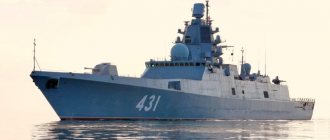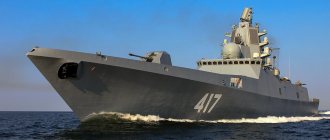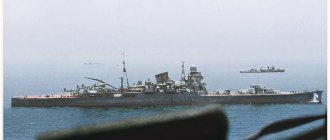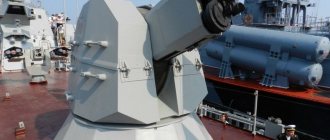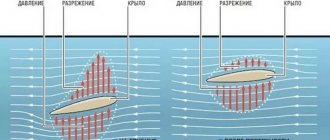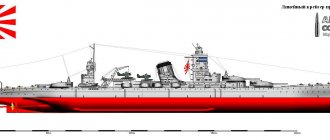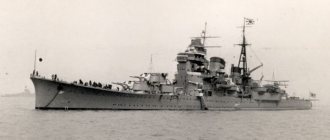Tests of the modernized frigate Marshal Shaposhnikov are being completed in Vladivostok. Built 35 years ago, the ship is now equipped with the latest weapons systems and has actually received a rebirth. Today, the frigate has no equal in the Russian Navy in terms of the number of anti-ship missiles deployed on board. In the coming years, the large anti-submarine ship Admiral Vinogradov will undergo similar repairs. Military historian Dmitry Boltenkov looked into what resources Soviet-built ships had left and how they could be used.
Construction queue
Currently, the Russian Navy consists primarily of warships built during the Soviet era. Plus several that were completed after 1991 and left the stocks in the 2010s. In the 1990s and early 2000s, due to objective difficulties, Russia lost an entire generation of warships. The cyclical nature of military shipbuilding has been disrupted, and it is extremely difficult to get back into the rhythm. As a result, the Navy is experiencing serious problems with its available ship personnel, primarily with ships in the ocean and long-sea zones.
One move forward-1
Parade of the Navy (Navy) in Kronstadt
Photo: IZVESTIA/Alexander Kazakov
Return of the corvette: why the Navy decided to resume postponed projects
The Russian fleet will receive new warships of the 20380 and 20385 series
Today, new frigates and corvettes are being built, but in insufficient quantities. By the way, the Soviet Union could not provide itself with all the necessary ship personnel - both for the Navy and for civilian structures. A large number of warships and auxiliary vessels were built in the GDR, Poland and Finland. Moreover, after the collapse of the USSR, Russia lost the opportunity to build ships and vessels in Ukraine. However, at the moment there is little left of the factories in Nikolaev.
There is also a huge need to update the fishing fleet (this is important for the country’s food security), the transport fleet, ships of various departments, as well as the passenger fleet. The pandemic forced the state to pay attention to domestic tourism and, in particular, to river tours. As a result, not all the capacity of shipyards can be used for the construction of warships.
One move forward-2
Navy flag on the patrol ship "Dmitry Rogachev"
Photo: IZVESTIA/Zurab Javakhadze
“Daly” frigate: the Pacific borders will be protected by a ship with “Zircons”
The Admiral Vinogradov BOD will be modernized and equipped with powerful missiles
In this regard, along with the construction of new ships, it makes sense to extend the service of Soviet-built ships as much as possible. This is possible both through repairs with restoration of technical readiness, and repairs with modernization. In the first case, the body and various systems are repaired, and some devices are changed. The ship's service life is being extended by three years, but its combat capabilities remain at the existing level. Thus, the Northern Fleet is carrying out similar work on the destroyer Admiral Ushakov and the large anti-submarine ship Admiral Levchenko. In 2020, similar repairs were completed on the missile cruiser Moskva.
Surface military fleet of the USSR. part 2
- Published: 10/13/2015, 20:13
- Seal
Contents of the material
- Surface military fleet of the USSR. part 2
- All pages
Page 1 of 32
USSR surface navy
The section was created on the basis of the book by senior researcher Kuzin Vladimir Petrovich and senior researcher Nikolsky Vladislav Ivanovich “The History of the Creation of the Post-War Navy of the USSR and the Possible Shape of the Russian Navy” and other materials.
part 2
part 1
part 3
part 4
part 5
SURFACE COMBAT SHIPS OF THE USSR NAVY, BUILT IN 1945-1991.
Aircraft carriers.
Contrary to the rather common views about the imbalance of the pre-war programs for the construction of the ocean fleet, it should be resolutely stated that our naval science in the past, in general, correctly assessed the role and importance of naval aviation in the future armed struggle at sea (back in the distant 20s there were plans for re-equipment unfinished battle cruiser "Izmail" into an aircraft carrier for 40-50 aircraft).
The unfinished battle cruiser “Izmail” in tow from the icebreaker “Lenin”...
This is confirmed by the development in the thirties of preliminary design 71, essentially the first Soviet aircraft carrier, which was included in the pre-war program for the construction of an ocean-going fleet. As is known, the Second World War and the undivided dominance of the “young school” in the minds of the Navy leadership prevented its implementation; project 71 became morally obsolete in a relatively short time, so already in 1944 a pre-draft design of a new ship appeared under number 72.
Project 72 aircraft carrier 1944. Displacement - standard - 23700 tons; full - 28800 tons; Length - 224 m; Width - 27.9 m; Draft - with standard displacement - 7.23 m; at full displacement - 8.45 m; Side height - 20.9 m; Power plant - 4 main turbo-gear units with a capacity of 36,000 hp; 8 boilers with a capacity of 73 t/h; Speed - maximum - 30 knots; Cruising range - 18 knots 10,000 miles; Armament - 30 aircraft; 16 (8 x 2) - 130 mm guns (later - 8 x 2 - 85 mm); 24 (12 x 2) - 37 mm guns; 8 (4 x 2) - 23 mm guns (later - 4 x 2 - 25 mm); Reservation - side - 90 mm; flight deck - 30 mm; hangar deck - 55 mm; Team - about 2000 people.
Only in 1953 were design studies resumed on a light aircraft carrier for 40 aircraft, and in 1955 its preliminary design was developed. Analyzing the development of aircraft carriers abroad, our specialists did not ignore the appearance of the super-aircraft carrier Forrestal in the United States and in 1959 completed design studies for an attack aircraft carrier for 60 and 100 ship-based aircraft (LAC).
However, the mentioned projects and developments remained a part of history, since military shipbuilding was once again invaded by new views not only of political leaders, but also of “theorists” who absolutized new means of armed struggle - nuclear weapons, missiles, nuclear submarines.
The scientific and technological revolution that began in the navy was the dictate of the times, however, it was accompanied in a number of cases by extremes and distortions. Officially, naval aviation continued to be considered one of the main branches of the Navy, but fighter aircraft were removed from its composition. The issue of air cover for ships even off the coast was simply hushed up.
During this period, great hopes began to be pinned on the advent of shipborne helicopters. The helicopter was relatively quickly landed on the ship and assigned one of its main functions - searching for and destroying submarines. In accordance with the anti-submarine priority that triumphed in surface shipbuilding, in the early 60s the design and then construction of the first domestic ships with a group of helicopters—long-range anti-submarine warfare ships—began. The lead ship of Project 1123, named “Moskva” and officially classified as an anti-submarine cruiser, was built at the Black Sea Shipyard and delivered to the fleet in 1967.
"Condor" - "Moscow" - Soviet and Russian anti-submarine cruiser-helicopter carrier, lead ship of Project 1123. Two ships were built - "Moskva" and "Leningrad". Main characteristics: Standard displacement 14,950t; total 17,500 tons; Length - 189 m (620ft); Width 23m (75ft); Draft 13 m (43ft); Power 100,000 l. With.; Maximum speed 31 knots; number of helicopters - 18 Kamov Ka-25 or Mi-8. (data on foreign press)
Indeed, it was a fundamentally new ship for our fleet. With an architectural layout known since the 1930s - fodder for aviation (Swedish air transport cruiser Gotland (1934), converted Japanese battleships-aircraft carriers Ise and Hyuga (1943), French cruiser-helicopter carrier " Joan of Arc" (1963),
Cruiser - helicopter carrier "Jeanne D'Arc" ("Jeanne d'Arc") Main characteristics: Standard displacement 10575 tons; total 13270 t; Length - 172 m (maximum - 182 m); Width 24 m; Draft 7.30 m; Power 40,000 l. With.; Maximum speed 26.5 knots; Cruising range - 6800 miles at 16 knots; Crew: 31 officers, 182 junior officers, 414 sailors, 140 cadets.
Italian cruisers "Andrea Dorea" and "Caio Duilio" (1964) - our designers at the Nevsky Design Bureau, whose team was headed by A.S. Savichev, had to rework the hull shape (double wedge), solve complex aerodynamic problems, place an extended under-deck hangar and aircraft equipment, layout of the runway.
Anti-submarine cruiser of the Moscow type * (project 1123): displacement - 11000-11300 tons, speed - 29 knots, armament: 14 Ka-25 anti-submarine and search and rescue helicopters (4 runways, 2 helicopter lifts), 1 twin launcher for anti-submarine missiles "Vikhr", 2 rocket launchers RBU-6000, 2 twin launchers for medium-range anti-aircraft missiles "Storm", 2 twin universal artillery installations of 57 mm caliber, 2 five-tube torpedo tubes of 533 mm caliber, power plant capacity - 90,000 l .s, cruising range at 18 knots - 6000 miles, length -190 m, width - 35 m, draft - 9 m, crew - 541 people, with aviators - 840 people.
In the figure the numbers indicate: 1— RBU-6000 rocket launchers; 2 - anti-submarine missile complex "Vikhr"; 3 - anti-aircraft missile system "Storm"; 4 — antennas for the “Don” navigation radar; 5 — antennas for the “Storm” fire control radar; b - antennas for radar warfare systems; 7 - 9 - radar antennas; 10 - 57mm artillery mounts; 11 — torpedo tubes; 12 — K-25 helicopters; 13 — starting command post; 14 — take-off and landing pads; 15 – helicopter lifts
From the Navy, the design was first supervised by Captain 2nd Rank V.F. Fedin, and then Captain 2nd Rank I.S. Platonov. Based on anti-submarine missions, a full set of anti-submarine weapons and weapons was installed on the cruiser: an anti-submarine missile system: the Vikhr missile system with a two-boom homing launcher, two five-tube 533-mm torpedo tubes (later dismantled), two RBU-6000 type RBUs, a GAK "Orion" and towed sonar "Vega". To protect the ship from air attack, two M-11 “Storm” anti-aircraft missile systems and two two-gun 57-mm AK-725 anti-aircraft guns were placed on it for the first time. Illumination of the air situation was provided by two radars: “Voskhod” and “Angara”. 12 Ka-25 anti-submarine helicopters were located in below-deck and 2 in above-deck hangars; four runways were equipped for their takeoff and landing. The total displacement of the ship exceeded 15,000 tons.
Two years later, after the lead ship, the same plant transferred the second, same-type cruiser Leningrad to the fleet. For the sake of objectivity, it should be noted that the TTZ requirement for these ships to accommodate 14 helicopters turned out to be erroneous. Practice quickly pointed out the main drawback - the limited number of air squadrons, which did not ensure that the assigned tasks were completed in full. In addition, unsatisfactory seaworthiness in stormy conditions was revealed, which was caused by excessively full contours of the stern and U-shaped formations of the bow frames. (By the way, the same drawback was inherent in the pre-war destroyers of Project 7, which was somehow forgotten then.) The ship was clearly not long enough, which was visible, as they say, with the naked eye. In the second half of the 60s, when views on the surface fleet began to change in a favorable direction, this was immediately reflected in the adjustment of the Moskva cruiser project.
The third ship was laid down with an increase in length by 12 m, which was supposed to provide improved unsinkability, seaworthiness and habitability, and most importantly, increase the number of the air squad.
Diagram of the general arrangement of the anti-submarine cruiser "Moscow" (1967): a - side view; b - top view; c—longitudinal section
1—work boat; 2— Ka-25 helicopter; 3 — antenna post (AP) of the Don navigation radar; 4 — launch command post (SCP); 5 - AP means of electronic warfare; 6 — AP artillery fire control system “Bars”; 7 - AP radar "Voskhod": 8 - AP radar "Angara-A"; 9 — AP control system for the “Storm” air defense system; 10 — launcher (PU) of the “Storm” air defense system; 11 — launcher RPK “Vikhr”; 12 — RBU-6000 rocket launcher; 13 - 533 mm 5-tube torpedo tube; 14 — flight deck; 15 — runway for helicopters; 16 — helicopter lift; 17 - PU ZYF-111 for passive jamming; 18 — life rafts; 19 — two-gun automatic 57-mm artillery mount AK-725; 20 — crane for loading ammunition; 21 — salute 45-mm artillery mount 21-KM; 22 - six-oared yawl; 23 — rail tracks for loading ammunition; 24 — spire; 25 — cockpit; 26 — lower helicopter hangar; 17 - power plant; 28 — upper helicopter hangar; 29 — control station; 30 — radar post; 31 — officers’ cabins: 31 — wheelhouse; 33 — ammunition cellar; 34 - utility storerooms; 35— fuel tanks; 36 — chain box; 37 — provision storerooms: 38 — GAS fairing with lifting and lowering device (LOD); 39 — machine and boiler room; 40 — power compartment; 41 — room for anti-rolling mechanisms; 42 — steering gear room; 43— POU of the towed GAS “Vega” system
However, the increase in the number of helicopters created a new problem - the need to increase the number of runways from four to six, and, in addition, a separate runway was needed for an on-duty search and rescue helicopter. With a simple large-scale increase in the ship, all the previous shortcomings of the project “came out” again, and its radical reworking was required.
Anti-submarine cruiser "Moscow"…
There was only one optimal solution: to place seven runways on one line, i.e. create a “ribbon” or, according to the terminology adopted abroad, a “through” flight deck, which, in order to save the total length of the ship, is docked to the bow, occupied by weapons, at a slight angle of 4-5 degrees.
* Accepted abbreviations
- Forward
- Back
- Forward
Modernization of Shaposhnikov
In the case of repairs with modernization, in addition to the work mentioned, combat equipment is also replaced, as a result of which the ship receives new combat capabilities, and its service life is increased by at least 10 years. During the repair and modernization, new types of weapons and radio electronics were installed on the Marshal Shaposhnikov BOD. Now the BOD carries 32 cruise missiles of the Caliber and Zircon complexes on board - this is more than double the number of missiles on the Varyag cruiser. Boilers and refrigeration machines were also replaced, and other systems were significantly updated. The hull has been repaired. In general, the result was a powerful warship; its class even changed - from a BOD it became a frigate. Remarkably, the graceful silhouette remains the same.
Next up is “Vinogradov”
The alteration of “Shaposhnikov” was carried out in Vladivostok in . The results obtained will be used to modernize the next BOD Admiral Vinogradov. Moreover, according to available data, he will be armed even more powerfully. New anti-aircraft and anti-submarine systems will be installed on board the Vinogradov.
One move forward-3
Large anti-submarine ship (BOD) "Marshal Shaposhnikov"
Photo: RIA Novosti/RF Ministry of Defense
Ship repair, and even modernization, is a complex and expensive business. It is often easier to build a new ship. First, you need to create a modernization project, and at a new technological level, determine what and how to repair, and what to replace. By the way, problems usually arise with this, since the real condition of the ship can only be determined after opening the decks and mechanisms.
Many suppliers of equipment and mechanisms no longer exist; we need to look for new manufacturers. The Ministry of Defense may change its requirements during the process, wanting to get a more advanced ship - for example, in connection with the advent of new electronics or weapons.
One move forward-4
Large anti-submarine ship (BOD) "Admiral Vinogradov"
Photo: RIA Novosti/RF Ministry of Defense
Coast Guards: Kamchatka will be protected by the latest corvettes
Anti-submarine attack ships will be sent to the defense of the peninsula
But in the case of the Pacific BOD of Project 1155, all these problems have already been solved. So the restructuring of the Admiral Vinogradov will take less time than it took to rebuild the Shaposhnikov. It will be followed by Admiral Tributs and Admiral Panteleev. As a result, by the end of the 2020s, the Pacific Fleet will have at least eight frigates - four modernized and four newly built.
Navy warships
In this section of our website you can find information on Navy warships of various classes: aircraft carriers, artillery and missile cruisers, destroyers, patrol and small missile ships, minesweepers, etc.
Articles on the following projects are available for use:
Project
| Note | |
| pr.29K | Patrol ship |
| pr.30K | Destroyer |
| pr.30bis | Destroyer |
| pr.35 | Patrol ship |
| Project 41 | Destroyer |
| Project 42 | Patrol ship |
| pr.50 | Patrol ship |
| pr.53U | Basic minesweeper |
| pr.56 | Destroyer |
| pr.56M | Destroyer |
| pr.57bis | Destroyer |
| pr.58 | Missile cruiser |
| pr.61 | Large anti-submarine ship |
| Project 61ME | Large anti-submarine ship |
| pr.68bis | Light cruiser |
| pr.68K | Light cruiser |
| pr.73K | Basic minesweeper |
| pr.80 | Landing craft |
| Project 82 | Heavy cruiser |
| Project 103 | Non-self-propelled cord charge stacker |
| Project 106 | Small landing ship |
| Project 106K | Small landing ship |
| Project 122A | Great submarine hunter |
| pr.122bis | Great submarine hunter |
| Project 149 | Network barrier |
| Project 151 | River minesweeper |
| Project 159 | Patrol ship |
| Project 159A | Patrol ship |
| Project 188 | Medium landing ship |
| Project 189 | Small landing ship |
| Project 201 | Small anti-submarine ship |
| Project 204 | Small anti-submarine ship |
| pr.253L | Raid minesweeper |
| Project 254 | Sea minesweeper |
| Project 255 | Raid minesweeper |
| Project 257D | Basic minesweeper |
| Project 257DM | Basic minesweeper |
| Project 257M | Mine detector ship |
| Project 264 | Sea minesweeper |
| Project 265 | Basic minesweeper |
| Project 266 | Sea minesweeper |
| Project 266M | Sea minesweeper |
| Project 306 | Landing craft |
| Project 317 | Network barrier |
| Project 355 | Self-propelled mine rafts |
| Project 388M | Basic minesweeper |
| Project 442 | Trawl barge |
| Project 450 | Small landing ship |
| Project 502 | Small anti-submarine ship |
| Project 503 | Small anti-submarine ship |
| Project 572 | Raid minesweeper |
| pr.697TB | Raid minesweeper |
| Project 699 | Basic minesweeper |
| Project 770 | Medium landing ship |
| Project 771 | Medium landing ship |
| Project 773 | Medium landing ship |
| Project 775 | Large landing ship |
| Project 778 | Large landing ship |
| Project 839 | Non-self-propelled cord charge stacker |
| Project 903 | Small ekranoplan rocket ship |
| Project 904 | Small amphibious ekranoplan ship |
| Project 956 | Destroyer |
| Project 963 | Air surveillance ship |
| Project 1123 | Anti-submarine cruiser |
| Project 1124 | Small anti-submarine ship |
| Project 1124M | Small anti-submarine ship |
| Project 1134 | Missile cruiser |
| Project 1134A | Large anti-submarine ship |
| Project 1134B | Large anti-submarine ship |
| Project 1135 | Patrol ship |
| Project 11356 | Patrol ship |
| Project 1141 | Small anti-submarine ship |
| Project 1143 | Heavy aircraft-carrying cruiser |
| Project 11434 | Heavy aircraft-carrying cruiser |
| Project 11435 | Heavy aircraft-carrying cruiser |
| Project 11437 | Heavy nuclear aircraft carrier |
| Project 1144 | Heavy nuclear missile cruiser |
| Project 11442 | Heavy nuclear missile cruiser |
| Project 11451 | Small anti-submarine ship |
| Project 1155 | Large anti-submarine ship |
| Project 11551 | Large anti-submarine ship |
| Project 1159 | Patrol ship |
| Project 1164 | Missile cruiser |
| Project 1171 | Large landing ship |
| Project 11711 | Large landing ship |
| Project 1174 | Large landing ship |
| Project 1176 | Landing craft |
| Project 1190 | Monitor |
| Project 1205 | Landing craft hovercraft |
| Project 1206 | Landing craft hovercraft |
| Project 1206T | Air-cushion minesweeper |
| Project 12061 | Landing craft hovercraft |
| Project 1208 | Small artillery ship |
| Project 1209 | Landing craft hovercraft |
| Project 1232 | Small landing hovercraft |
| Project 12321 | Small landing hovercraft |
| Project 12322 | Small landing hovercraft |
| Project 1234 | Small rocket ship |
| Project 1234E | Small rocket ship |
| Project 12341 | Small rocket ship |
| Project 12347 | Small rocket ship |
| Project 1239 | Rocket hovercraft |
| Project 1240 | Small rocket ship |
| Project 1252 | Basic minesweeper |
| Project 1253 | Basic minesweeper |
| Project 1253A | Basic minesweeper |
| Project 1253V | Basic minesweeper |
| Project 12531 | Basic minesweeper |
| Project 1256 | Basic minesweeper |
| Project 1258 | Raid minesweeper |
| Project 1259 | River minesweeper |
| Project 1265 | Basic minesweeper |
| Project 1328 | Basic minesweeper |
| Project 1330 | Raid minesweeper |
| Project 1331M | Small anti-submarine ship |
| Project 1332 | Sea minesweeper |
| Project 1338P | Raid minesweeper |
| Project 1785 | Landing craft |
| pr.02510 | Landing craft |
| pr.02800 | Landing assault boat |
| Project 10750 | Raid minesweeper |
| Project 11540 | Patrol ship |
| Project 11660 | Patrol ship |
| Project 11661 | Patrol ship |
| Project 11770 | Landing craft |
| Project 12255 | Basic minesweeper |
| Project 12412 | Small anti-submarine ship |
| Project 12660 | Sea minesweeper |
| pr.12700 | Basic minesweeper |
| Project 12821 | Basic minesweeper |
| pr.13000 | River minesweeper |
| Project 20351 | Small anti-submarine ship |
| pr.20380 | Patrol ship |
| pr.20386 | Corvette |
| Project 21630 | Small artillery ship |
| Project 21631 | Small rocket ship |
| Project 21820 | Landing craft |
| Project 22160 | Patrol ship |
| Project 22350 | Frigate |
| pr.22800 | Small rocket ship |
| Project 23320 | Landing craft hovercraft |
| Project 23550 | Patrol ship |
| pr.23900 | Universal landing ship |
| Ave. A-3 | Landing craft |
| Ave. T-4 | Landing craft |
| Project T351 | Minesweeper boat |
| Project T361 | Minesweeper boat |
| Project T388 | Raid minesweeper |
| Project T389 | Minesweeper boat |
| type BUKS | Cord charge stacker |
| type Inspector Mk2 | Uncrewed mine countermeasures boat |
| Lake type | Raid minesweeper |
| Mistral type | Landing helicopter dock ship |
| type T1 | Network barrier |
| type F | Fast landing barge |
| Hi Fen type | Patrol ship |
| type Japanese C | Patrol ship |
| type Japanese D | Patrol ship |
| type MAL II | Landing transport |

